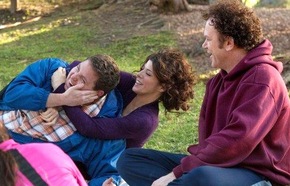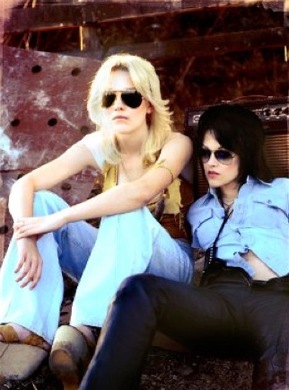
I saw my final film of Sundance 2010 here in Chicago. It was my best Sundance experience, and I want to tell you why. The film was "Jack Goes Boating," the directorial debut of Philip Seymour Hoffman. It played here in the Music Box, as part of the "Sundance USA" outreach program, which has enlisted eight art theaters around the country to play Sundance entries while the festival is still underway.
The Music Box is the largest surviving first run movie palace in Chicago. It is deeper than it is wide, and has an arching ceiling where illusory clouds float and stars twinkle. Many shows are preceded by music on the organ.
That's all very nice, but doesn't explain why this particular screening was so enjoyable. Every one of the 750 seats was filled. These people were not festival goers, nor were they all critics, bloggers or distributors. They were movie lovers who ventured out at night in the cruel Chicago winds with the temperature standing at 14F, and paid cash for their tickets because they wanted to see Hoffman's new movie.
The screening felt...different. "Jack Goes Boating" is not a comedy but it has a great many funny moments. The audience laughed a lot. The warm acoustics of the room curved the laughter back and enfolded us. In acoustic terms, we became an audience. In spaces that are wider than deep, such as Sundance's Eccles and the Lumiere at Cannes, one gets a sensation of separation; at Cannes, curiously, much of the laughter seems to center on the front right. At a narrower theater like the Music Box, you feel joined together.

There is also the matter of how people laugh: Are they responding, or informing? At the Music Box, the audience seemed to respond as an organic whole. At most festivals and all industry screenings, they seem made more of individual voices essentially saying: "I'm instructing you that that was funny."
Then there is the question of who is in the audience. The average age at the Music Box probably skewed to 16-35. It was self-selected: These people were interested enough in Sundance and Philip Seymour Hoffman to leave home in frigid cold. At many screenings, particularly the "sneak previews" at which critics are invited to join an audience of radio station listeners who got free tickets, the audience often doesn't know or care about the movie, and they respond as in terms of peer communication rather than shared experience.

In short, what I felt in my bones at the Music Box was the experience a working movie critic rarely shares, the sensation of seeing a movie in a room filled with people who are there of their own will, sympathize with movies, and respond genuinely. Although the movie won favorable reviews from the trades at Sundance (Variety, Hollywood Reporter, Screen International), my guess is that the audience reaction was better at the Music Box than at Park City. Since reps of the movie would have been present at both screenings, they could make their own guess, although prudence suggests they won't tell us.
Now onward to good movies I saw at Sundance 2010. (I'm giving the others a pass, since why knock indie efforts before they open?) Alphabetically:

"Blue Valentine" How do we fall in love? How do we lose that early enchantment? Derek Cianfrance's uses the powers of two fine actors, Michelle Williams and Ryan Gosling, to chart the before, during and after a marriage. They meet in a sweet way, while both are visiting relatives in an old folks' home. They're filled with optimism and promise. But he seems to lack all initiative, and retreats inward while she remains more open. The reappearance of her old boyfriend, not a nice man, creates psychological difficulties -- and a wounding issue of trust. The film cuts between past and present with different visual styles; we see two people who might still be happy if they could only talk to one another.

"Cane Toads: The Conquest" Remember the first cane toads movie from 1988? It told the saga of toads unwisely imported from Hawaii to Australia to attack destructive beetles. The toads flourished in the new environment, multiplying to millions, infesting the Northern Territory and sometimes carpeting highways so thickly they made driving unsafe.
Now director Mark Lewis has updated the story in 3-D. A decade later, there are more toads than ever; they swim rivers, penetrate all man-made barriers, and allegedly number more than a billion. It's essentially the same story as in 1988, with the addition of testimony by colorful locals and a good clear 3-D picture (which doesn't seem necessary). The only element missing from the earlier film is the popular recycling of toad secretions into a smokable drug. No doubt this intriguing use was sidestepped to get a G rating for the 3-D family audience.

"Cyrus" This film by the Duplass brothers, Jay and Mark, was one of the most popular this year. Starting as a full-bore comedy and then exploring some darker consequences, it benefits from the casting of John C. Reilly and Marisa Tomei as two shy lovers, and particularly by Jonah Hill as her assertive and sneaky 21-year-old son. It also includes Catherine Keener, but then every film benefits from casting her. Reilly is a socially inept but nice, sincere divorced guy who meets the long-single Marisa Tomei at a party. She comes home with him, they click, and then in a unexpected way he meets her son Cyrus, who she wasn't quite ready to tell him about. Cyrus is overweight, smart, so confident he's scary, and very possessive of his mom.
Tomei has the pivotal role here, because she must balance two deep emotions and play fair, and Cyrus does all he can to prevent that. This is the kind of comedy where we recognize elements of real life and laugh partly in relief that most of us have escaped them. I won't reveal more. Marisa Tomei has always struck me as one of those actresses who is particularly good at conveying warm affection, which must be pretty hard to fake. It's invaluable here.

"Jack Goes Boating" opens with two friends who are New York limo drivers. Jack (Philip Seymour Hoffman) is a reclusive bachelor, and Clyde (John Ortiz) and his wife Lucy (Daphne Rubin-Vega) are just about his only friends. He has a paralyzing shyness around women, so Lucy fixes him up with her friend Connie (Amy Ryan). Lucy and Connie work in phone sales for a funeral parlor. The first date ends promisingly, with Jack asking for and receiving "a little good night kiss." Their next big date involves Jack cooking dinner for them all at Clyde and Lucy's apartment, and it goes about as badly as possible -- through no fault of theirs.
Hoffman, Ortiz and Vega-Rubin played these roles in the original play by Bob Glaudini, which they produced at their off-Broadway theater, LAByrinth. Hoffman didn't intend for this to be his filmmaking debut, but it turned out that way, and he made adjustments to open it up and tune it down, as theater must usually be when faced with the intimacy of film. The work is endearing about Jack and Connie, but its complexity involves Clyde and Lucy, who have had, as they both note, to "work out a lot of things" during their marriage. The film's achievement is finding a balance between its good humor and its unhappy truths.

"Joan Rivers: A Piece of Work" If ever a movie has an accurate title, this is the movie. Joan Rivers gave the filmmakers access to her life for a year, she was frank, open and honest, and the result is one of the most truthful documentaries about show business I've seen. Also maybe the funniest. Rivers has inevitably become identified with her red carpet appearances, but this film contains not one red carpet shot and only a few passing mentions. It focuses on the standup comedian, who works ceaselessly, and remains at the top of her form.
Rivers is 75, something she repeats several times, and at 67 myself I know it sounds condescending to say she hasn't lost a beat, but she hasn't. She remains one of the most transgressive and fearless of comedians, and one of the quickest, fastest and most merciless. The doc shows a life force of formidable energy. In one stretch she closes a show in Toronto, flies overnight to Palm Springs, does a gig, flies overnight immediately back to Minneapolis, and performs another one. She's upfront about plastic surgery, her husband Edgar, her daughter Melissa, and how after she left as Johnny Carson's permanent guest host he never spoke to her again and she was blackballed by NBC until last year. In the Q&A session Rivers gave her opinion of the Leno/Conan/NBC matter: "Fuck 'em all." Urgent to MSNBC: Feature this woman as a guest commentator and crawl under your desks.

"The Runaways" A somewhat fictionalized version of the life and times of the 1975-77 teenage girl rock band best known for Joan Jett (Kristen Stewart) and Cherie Currie (Dakota Fanning). No members were over 16 when they were packaged as "jailbait rock" by snaky producer Kim Fowley (Michael Shannon). They dressed like hookers and dominatrixes, they idolized the Sex Pistols, but they were also insecure and immature young girls. Currie almost went down in flames, and the movie is based on her autobiography, Neon Angel.
Joan Jett still tours today, and is an intact survivor. The movie reproduces the Runaways' actual music, which is no better than you might expect, but the acting is very convincing. Kristen Stewart proves once again that she's a rising star, and Dakota Fanning is such a fine actress that I, for one, almost believed I'd always heard her using the f-word. As for Michael Shannon, is he the most unheralded force in acting today, or what?

"Twelve" is a "Less than Zero" for 2010, a savage portrait of a crowd of stupid rich kids on the Upper East Side, and how they spend their parents' money to create perhaps irreversible damage to their lives. Holden Caulfield would have been thrown into catatonia after five minutes with them. Chace Crawford is very good as the alleged hero, White Mike, who doesn't smoke or drink and dropped out of private school to devote himself full-time to marijuana sales. Emma Roberts plays Molly, an essentially nice girl he falls for, and Esti Ginzburg is the Popular Blonde who tells a younger kid (Rory Culkin) that if he makes his parents' apartment available for her birthday party, she'll sleep with him.
The title comes from a trendy new drug White Mike doesn't deal in, but he gets some from another dealer (50 Cent) to supply for party night. The film is very well acted, and dark, dark, dark. The director is Joel Schumacher, assured and fearless on a small budget and short shooting schedule which seems to add spontaneity. Schumacher is not fashionable with Sundance types, and I suspect this will emerge from the festival with reviews that don't concede its power. But it will perform.

Welcome to the Rileys was one of the buzz champs of Sundance 2010. The discovery once again is Kristen Stewart, who after this year's festival can be considered completely rehabilitated after the "Twilight" films. The lead is James Gandolfini, as an Indianapolis plumbing contractor who goes to New Orleans on a business trip and meets (quite innocently) a runaway lap dancer who may be 16. At home, his wife (Melissa Leo) hasn't been able to leave the house after their own daughter's death, and Gandolfini decides on the spot to sell his business, stay in New Orleans, and rescue this angry and damaged girl.
That sounds like unlikely melodrama? So it is. But Gandolfini, Stewart and Leo inhabit it with persuasive performances, and director Jake Scott uses French Quarter locations that add another level of atmosphere. Gandolfini does something here he often does, as in John Turturro's "Romance & Cigarettes" (2005): He demonstrates that although he may not be conventionally handsome, when he smiles his face bathes you in the urge to like him. Kristen Stewart here is tougher even than her punk rocker in "The Runaways." Who knew she had these notes? I'm discovering an important new actress.
Roger Ebert was the film critic of the Chicago Sun-Times from 1967 until his death in 2013. In 1975, he won the Pulitzer Prize for distinguished criticism.





